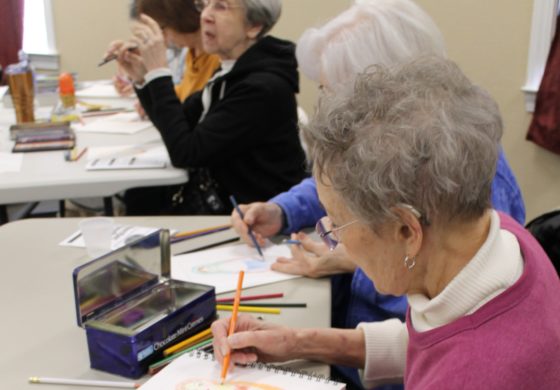By Page H. Gifford
Correspondent
 Artist and teacher Susan Patrick discussed color theory with members of the Fluvanna Art Association at the Jan. 18 monthly meeting. Artists study color theory in art school and apply the science behind it to their work. Once they understand the concepts, they learn to play with color and manipulate it to achieve a final result in their work.
Artist and teacher Susan Patrick discussed color theory with members of the Fluvanna Art Association at the Jan. 18 monthly meeting. Artists study color theory in art school and apply the science behind it to their work. Once they understand the concepts, they learn to play with color and manipulate it to achieve a final result in their work.
Artists learn that color is an important element in their work. Knowing color theory goes a long way in helping artists define their work. Color has a strong effect on the onlooker by creating mood. Without understanding the foundation of color and what it can do, the paintings will fall flat. Every artist wants their painting to be striking through the use of color. Even black and white, if done right, can make a profound statement.
Patrick herself uses color to make bold statements in her abstracts. Her work, reminiscent of artist Wassily Kandinsky and other modernists of the 20th century, may be difficult for the viewer to decipher. Her watercolors are conceptual in nature but her use of color makes its own statement about the work.
Patrick began with the basics, starting with the color wheel. She explained what most artists and children know at an early age: There are three primary colors – red, yellow and blue – and all the other colors are derived from these.
She didn’t elaborate on the history of color, which can be as intense and scientific as the subject itself. Those who have taken color theory in art school know the background, starting with Leone Battista Alberti in 1435 and Leonardo da Vinci in 1490, an artist who glorified the science of art. Later controversy surrounding Isaac Newton’s theory of color in the 18th century, regarding the nature of the primary colors, eventually developed into its own theory involving only minor references to the science behind it (color perceptions, spectrums and vision science).
Patrick bypassed this, focusing on the colors themselves and the magic they create, giving guidance in color mixing and the visual effects of combinations. Once an understanding of the primary colors was established, she talked about secondary and tertiary colors. Any color wheel has all this information available. Her color wheel was very simple.
“Analogous colors [colors that are adjacent to each other on the color wheel] make a good color scheme and can be soothing,” she said. “Complimentary colors [opposite on the color wheel] are energizing and powerful, but are not soothing.” Artists and designers are aware of the warm and cool colors. Reds and yellows are warm and blue is cool. Anything that is secondary, such as yellow-orange or blue-green, would fall into these two categories. This is important so the artist can gauge the mood of the work, such as a warm golden meadow in early morning to a portrait done in cooler colors.
Some members had never been exposed to color theory, but with practice and further understanding they could experiment.
“A hue is mixed with another color, a tint is mixed with white, a tone is mixed with gray, and a shade is mixed with black,” Patrick said. Other terms are often heard regarding color, including chroma, the intensity of color and value which is the lightness or darkness of a color. Key color is the dominant color in a color scheme. This is an important element when planning a painting.
She discussed various color schemes and had the members try it out in a simple drawing project using colored pencils. “Other than the complimentary, there is split complimentary [two colors apart on the wheel], such as yellow-green and yellow-orange with purple,” she explained, “followed by a triad, for example, violet, orange and green.”
Members went away from the workshop with a better understanding of the significance color can play in art and that it at the heart of every creation.





